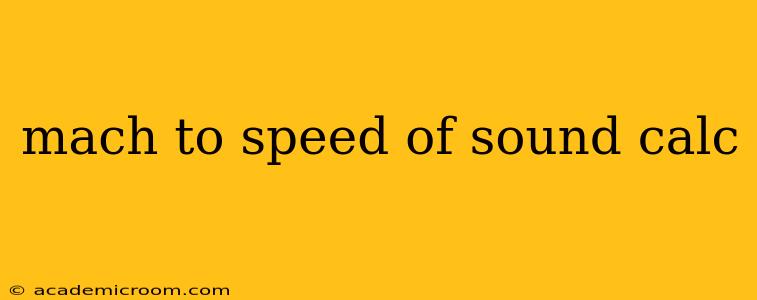Mach to Speed of Sound Calculator: Understanding Supersonic Speeds
The term "Mach" refers to the speed of an object relative to the speed of sound. A Mach number of 1 represents the speed of sound, Mach 2 is twice the speed of sound, and so on. But the speed of sound isn't a constant; it varies depending on several factors. This means a simple "Mach to speed of sound calculator" needs some context. Let's delve into the details.
What is the Speed of Sound?
The speed of sound is the distance traveled per unit time by a sound wave as it propagates through an elastic medium. This speed is primarily influenced by:
- Temperature: Higher temperatures mean faster sound waves. The speed of sound increases approximately 0.6 meters per second (m/s) for every degree Celsius increase in temperature.
- Medium: The material through which the sound travels significantly impacts its speed. Sound travels faster in solids than in liquids, and faster in liquids than in gases. Air is the most common medium we consider when talking about Mach numbers in aviation.
- Humidity: While less significant than temperature, humidity also slightly affects the speed of sound. Higher humidity generally leads to a slightly faster speed of sound.
- Altitude: The density of air decreases with altitude, leading to a slower speed of sound at higher altitudes.
Therefore, a precise conversion from Mach number to speed requires knowing the atmospheric conditions (temperature, altitude, humidity).
How to Calculate Speed from Mach Number
While a simple online calculator often provides a quick approximation, accurate conversion needs a more sophisticated approach. The formula is more complex than a simple multiplication:
The speed of sound (a) in dry air can be approximated by:
a ≈ 331.3 + 0.606 * T
Where:
- a is the speed of sound in meters per second (m/s)
- T is the temperature in degrees Celsius (°C)
Once you have calculated the speed of sound, you can determine the actual speed (V) in m/s using the Mach number (M):
V = M * a
To convert to other units (like kilometers per hour or miles per hour), use appropriate conversion factors.
How Does Altitude Affect the Calculation?
As mentioned earlier, altitude significantly affects the speed of sound. The standard atmosphere model provides data on temperature and pressure variations with altitude, which are crucial for accurate calculations. Using a standard atmosphere model (like the International Standard Atmosphere - ISA) and taking altitude into account would provide a more accurate speed of sound calculation at that altitude, impacting the final speed in your Mach to speed calculation.
What are some common uses of Mach numbers?
Mach numbers are frequently used in:
- Aerospace Engineering: Describing the speed of aircraft and rockets, especially in relation to the speed of sound (subsonic, transonic, supersonic, hypersonic).
- Fluid Dynamics: Analyzing the flow of fluids, particularly compressible flows where the speed of the fluid is comparable to the speed of sound.
What is the difference between supersonic and hypersonic speeds?
Supersonic speeds are those exceeding the speed of sound (Mach 1), while hypersonic speeds are significantly faster, generally considered to be Mach 5 or higher. Hypersonic flight presents unique challenges due to extreme temperatures and pressures generated by the interaction with the atmosphere.
In conclusion, while a quick online "Mach to speed of sound calculator" might suffice for rough estimations, understanding the factors affecting the speed of sound is crucial for accurate conversions. Using the formula above, incorporating altitude and temperature data, will yield more precise results.
